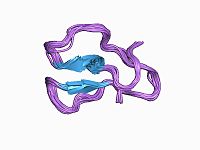
Photo from wikipedia
Great interests have recently been aroused in the independent associative domain of glycoside hydrolases that utilize insoluble polysaccharides-carbohydrate-binding module (CBM), which responds to binding while the catalytic domain reacts with… Click to show full abstract
Great interests have recently been aroused in the independent associative domain of glycoside hydrolases that utilize insoluble polysaccharides-carbohydrate-binding module (CBM), which responds to binding while the catalytic domain reacts with the substrate. In this mini-review, we first provide a brief introduction on CBM and its subtypes including the classifications, potential sources, structures, and functions. Afterward, the applications of CBMs in substrate recognition based on different types of CBMs have been reviewed. Additionally, the progress of CBMs in paper industry as a new type of environmentally friendly auxiliary agent for fiber treatment is summarized. At last, other applications of CBMs and the future outlook have prospected. Due to the specificity in substrate recognition and diversity in structures, CBM can be a prosperous and promising ‘tool’ for wood and fiber processing in the future.
Journal Title: Polymers
Year Published: 2022
Link to full text (if available)
Share on Social Media: Sign Up to like & get
recommendations!